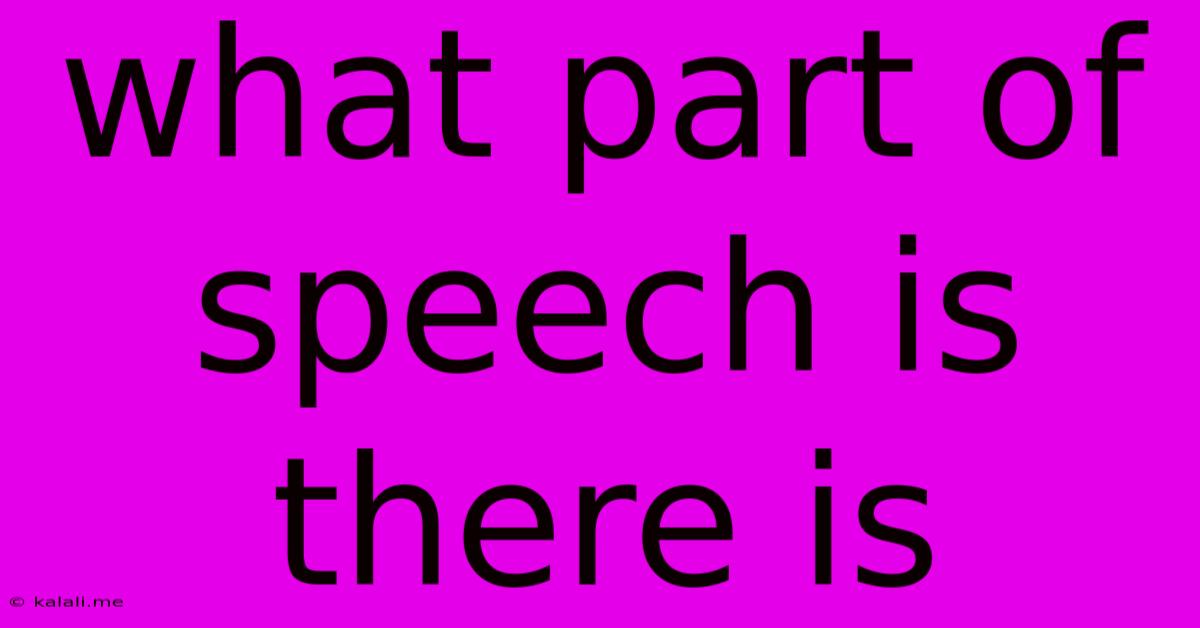What Part Of Speech Is There Is
Kalali
Jun 10, 2025 · 2 min read

Table of Contents
What Part of Speech Is "There Is"?
Meta Description: Unlock the grammatical mystery of "there is"! This article explores its function as a verb phrase, distinguishing it from other uses and clarifying its role in sentence structure. Learn about its variations and how to use it correctly.
The question of what part of speech "there is" represents often leads to confusion. While "there" might appear to be an adverb and "is" a verb, the phrase "there is" functions as a single unit—a verb phrase. It doesn't act as a simple subject-verb pairing in the traditional sense. Understanding its unique grammatical role is key to using it correctly.
"There Is" as an Existential Verb Phrase
The phrase "there is" (and its variations, such as "there are," "there was," "there were," etc.) is often called an existential verb phrase or an expletive construction. Its primary function is to introduce the true subject of the sentence, which usually follows the verb. The phrase itself doesn't describe an action; instead, it signals the existence of something.
Consider the sentence: "There is a cat on the mat."
-
There: This word doesn't refer to a physical location in the same way it would in a sentence like "The cat is there." In this sentence, "there" is a dummy subject or expletive. It simply fills the subject position grammatically.
-
Is: This is the verb, agreeing in number with the true subject.
-
A cat on the mat: This is the true subject of the sentence; it's what the sentence is actually about.
Distinguishing "There Is" from Other Uses of "There"
It's crucial to differentiate the existential "there" from other uses of the word. In other contexts, "there" can function as:
-
An adverb of place: "The book is there." Here, "there" indicates a location.
-
An adverb of direction: "Go there!" Here, "there" points towards a place.
-
An exclamatory word: "There! I saw a bird."
Variations of the Existential Verb Phrase
The existential phrase takes different forms depending on the tense and number of the true subject:
- Singular, present tense: There is, there's
- Plural, present tense: There are
- Singular, past tense: There was
- Plural, past tense: There were
Correct Usage and Common Mistakes
A common mistake is subject-verb disagreement when using the existential phrase. The verb must always agree with the true subject that follows it, not with "there."
Correct: There are many reasons for this. Incorrect: There is many reasons for this.
Conclusion: Understanding the Grammatical Function
Understanding that "there is" (and its variations) functions as an existential verb phrase is fundamental to accurate grammar. It's not simply a subject-verb combination; it's a grammatical structure that introduces the true subject of the sentence and signals the existence of something. Mastering its usage avoids common grammatical errors and ensures clear and precise writing.
Latest Posts
Latest Posts
-
Love God And Do What You Want
Jun 11, 2025
-
Another Word For On The Contrary
Jun 11, 2025
-
How To Fix A Scratch On Hardwood Floor
Jun 11, 2025
-
How Fast Can Iron Man Fly
Jun 11, 2025
-
How Long Does Isp Keep Records
Jun 11, 2025
Related Post
Thank you for visiting our website which covers about What Part Of Speech Is There Is . We hope the information provided has been useful to you. Feel free to contact us if you have any questions or need further assistance. See you next time and don't miss to bookmark.